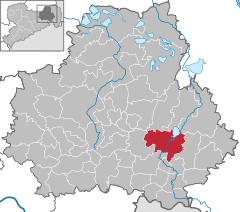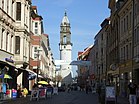
Back Bautzen Afrikaans Bautzen AN باوتسن Arabic باوتسن ARZ Bautzen Azerbaijani Баўтцэн Byelorussian Бауцен Bulgarian Bautzen Breton Bautzen Catalan Баутцен CE
Bautzen Budyšin | |
|---|---|
|
Clockwise from top: view of Bautzen, view over the city hall to the Czorneboh (Lusatian Highlands), historicizing bilingual Bautzen street signage, view of the city at dusk, Reichenturm, Main Market Square with town hall | |
Location of Bautzen Budyšin within Bautzen district  | |
| Coordinates: 51°10′53″N 14°25′27″E / 51.18139°N 14.42417°E | |
| Country | Germany |
| State | Saxony |
| District | Bautzen |
| Subdivisions | 15 |
| Government | |
| • Mayor (2022–29) | Karsten Vogt[1] (CDU) |
| Area | |
• Total | 66.62 km2 (25.72 sq mi) |
| Elevation | 204 m (669 ft) |
| Population (2022-12-31)[2] | |
• Total | 38,140 |
| • Density | 570/km2 (1,500/sq mi) |
| Time zone | UTC+01:00 (CET) |
| • Summer (DST) | UTC+02:00 (CEST) |
| Postal codes | 02625 |
| Dialling codes | 03591 |
| Vehicle registration | BZ, BIW, HY, KM |
| Website | www |
Bautzen (German pronunciation: [ˈbaʊ̯t͡sn̩] ⓘ) or Budyšin (Upper Sorbian pronunciation: [ˈbudɨʃin] ⓘ),[3][4][5] until 1868 Budissin in German, is a town in eastern Saxony, Germany, and the administrative centre of the district of Bautzen. It is located on the Spree river, is the eighth most populous town in Saxony, and is the seat of Saxony's largest district. Bautzen lies in the bilingual Sorbian settlement area (Serbski sydlenski rum) of Lusatia, and is Lusatia's third-largest town after Cottbus and Görlitz, as well as the second-largest town in Upper Lusatia.
The town lies in the hilly Upper Lusatian Gefilde (Hornjołužiske hona), a part of the northwesternmost foothills of the Sudetes, just north of the Lusatian Highlands. Bautzen is the first larger town on the Spree River (Spree→ Havel→ Elbe→ North Sea), and the Bautzen Reservoir (Budyska rěčna zawěra) lies in the north of the town. In 2021, Bautzen had a population of around 38,000.
Although Görlitz is larger, it is Bautzen that is regarded as the historical capital of Upper Lusatia. Bautzen is the political and cultural center of the entirety of the Slavic minority of the Sorbs (Upper and Lower), although Lower Lusatia and the Lower Sorbian-speaking Sorbs have an own, second center, which is Cottbus. About 10 percent of Bautzen's population is Upper Sorbian-speaking.[6] The use of the language is more widespread in the countryside surrounding the town than in the town itself. Bautzen is the seat of several Sorbian institutions like the Domowina, the German-Sorbian People's Theater (Němsko-Serbske ludowe dźiwadło), and Sorbian Broadcasting (Sorbischer Rundfunk, Serbski rozhłós).
From 1346 until 1815, the town was a member of the Lusatian League. The Bautzen Wenceslaus' Market (Bautzener Wenzelsmarkt, Upper Sorbian: Budyske Wjacławske wiki) is "Germany's oldest Christmas market mentioned in a chronicle".[7][8] Asteroid 11580 Bautzen is named in honour of the city.[9]
- ^ Gewählte Bürgermeisterinnen und Bürgermeister im Freistaat Sachsen, Stand: 17. Juli 2022, Statistisches Landesamt des Freistaates Sachsen.
- ^ "Einwohnerzahlen nach Gemeinden als Excel-Arbeitsmappe" (XLS) (in German). Statistisches Landesamt des Freistaates Sachsen. 2024.
- ^
- "SmartGuide — audio guide to Bautzen – Budyšin". Bautzen/Budyšin (bautzen.de).
- "Open symposium: 'Living together in Bautzen / Budyšin'". TU Dresden. 2021.
- ^ Howson, Phil (2017). "Upper Sorbian". Journal of the International Phonetic Association. 47 (3). Cambridge University Press: 359–367. doi:10.1017/S0025100316000414. JSTOR 26352395.
Upper Sorbian schools in Budyšin (German: Bautzen)
- ^ "Federal German labour minister, Hubertus Heil, is open for talks on the rights of the Sorbs/Wends". Serbski Sejm (Sorbian/Wendish People’s Representation). 12 August 2021.
the visit of the Federal Minister of Labor and Social Affairs, Hubertus Heil (SPD), to Budyšin/Bautzen on August 7
- ^ "2 + 2=1". brand eins (in German). Retrieved 2020-05-10.
- ^ "ÄLTESTER WEIHNACHTSMARKT | REKORD-INSTITUT für DEUTSCHLAND". rekord-institut.org. 10 December 2016. Retrieved 19 February 2024.
- ^ ONLINE, RP (9 December 2015). "Rekord-Institut für Deutschland: Welcher Weihnachtsmarkt ist der älteste?". RP ONLINE. Retrieved 19 February 2024.
- ^ "IAU Minor Planet Center".








